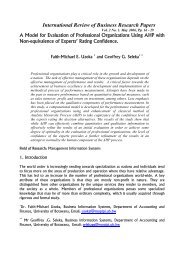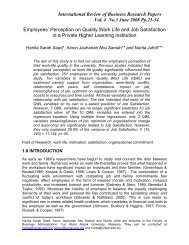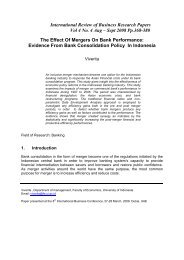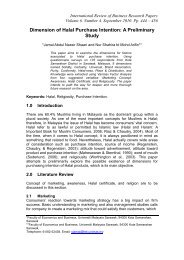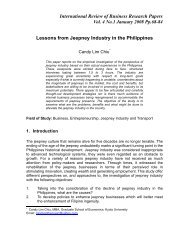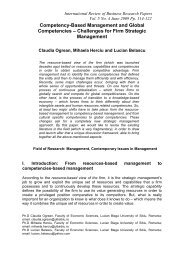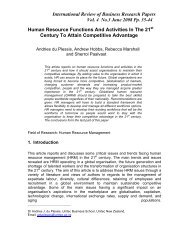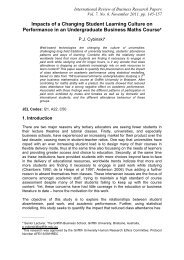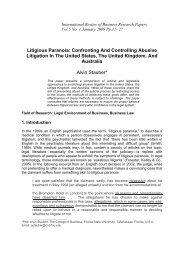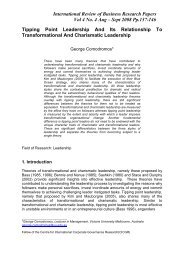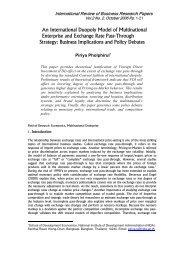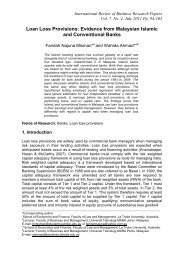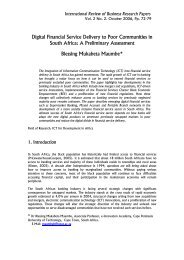Translation Exposure and Firm Value, Evidence From Australian ...
Translation Exposure and Firm Value, Evidence From Australian ...
Translation Exposure and Firm Value, Evidence From Australian ...
You also want an ePaper? Increase the reach of your titles
YUMPU automatically turns print PDFs into web optimized ePapers that Google loves.
Al-Shboul & Alison 193Firstly, the inclusion of accounting translation differences on a firm’s consolidatedincome statement <strong>and</strong> balance sheet may generate indirect cash flows, as a result oftaxation implications (Martin et al, 1998). Secondly, investors may use theconsolidated financial statements to predict the firm’s sales revenue, investmentgrowth opportunities <strong>and</strong> earnings. To the extent that these predictions are affectedby the firm’s translation exposure, it can be argued that this exposure also has thepotential to affect the firm’s share price. Finally, if potential investors use the level ofthe firm’s earnings to predict future dividend levels, then fluctuations in exchangerates, <strong>and</strong> their impact on the level of reported earnings, have the potential to impactthose predicted dividend payout ratios, <strong>and</strong> firm values (Asquith et al., 1983; Nance,Smith <strong>and</strong> Smithson, 1993). For these reasons, therefore, measuring the effect ofaccounting exposure on firm value remains an area of interest to both researchers<strong>and</strong> investors.The more recent research studies have produced somewhat mixed results. Most ofthe studies have, again, failed to provide any evidence of foreign currency translationadjustments being relevant to firm value (e.g., Callaghan & Bazaz, 1992; Soo & Soo,1994; Paurciau & Schaefer, 1995; Bartov & Bondar, 1995; Bartov, 1997; Dhaliwal etal., 1999). However, several studies have argued for such relevance (Hines, 1996;Godfrey & Yee, 1996; Martin et al., 1999; Louis, 2003; Pinto, 2005). The vast majorityof these studies have focused on investigating the U.S. market, <strong>and</strong>, to the currentauthors’ knowledge, research studies into the influence of translation exposure onthe value of <strong>Australian</strong> firms are limited in number. Godfrey (1992, 1994) examined,respectively, the importance of reporting the effects of <strong>Australian</strong> firms’ voluntaryforeign currency accounting policies on the value of the firms’ net assets, <strong>and</strong>managerial motivation for selecting among alternative, unregulated, <strong>Australian</strong>foreign currency translation methods. Godfrey <strong>and</strong> Yee (1996) examined the impactof the prescribed foreign currency translation adjustments of <strong>Australian</strong> St<strong>and</strong>ardsReview Board (ASRB) Statement No. 1012, Foreign Currency <strong>Translation</strong>, on thecurrency risk management practices of <strong>Australian</strong> mining firms. The reportingrequirements contained in ASRB 1012 had the effect of increasing the accountingexposure of firms to changes in exchange rates. The study found that <strong>Australian</strong>mining firms decreased the level of long-term foreign debt <strong>and</strong> increased the level ofequity capital in their capital structures, to mitigate the effects of the st<strong>and</strong>ard on theircontracts. These results suggested that management regarded increased translationexposure as having the potential to affect the market values of the relevant firms.The main contribution of the current study is the information it provides on therelationship between translation exposure <strong>and</strong> the market value of <strong>Australian</strong>multinational corporations, for the period January 2000 to December 2004. Followingthe methodology of Martin et al. (1998), the study examines the value relevance ofaccounting exposure through two examples of its measurement: the translatedshareholders’ equity <strong>and</strong> the translated operating earnings, from three geographicalregions [Asia-Pacific, Europe, <strong>and</strong> the North Atlantic Free Trade AssociationNAFTA)]. The inclusion of the translated operating earnings from those three regionsreflects the extensive engagement of <strong>Australian</strong> firms there, via foreign operations<strong>and</strong> subsidiary companies.The empirical results of the study reveal that, over the sample period, the cumulativeabnormal returns of the sample firms are positively associated with the incremental193



